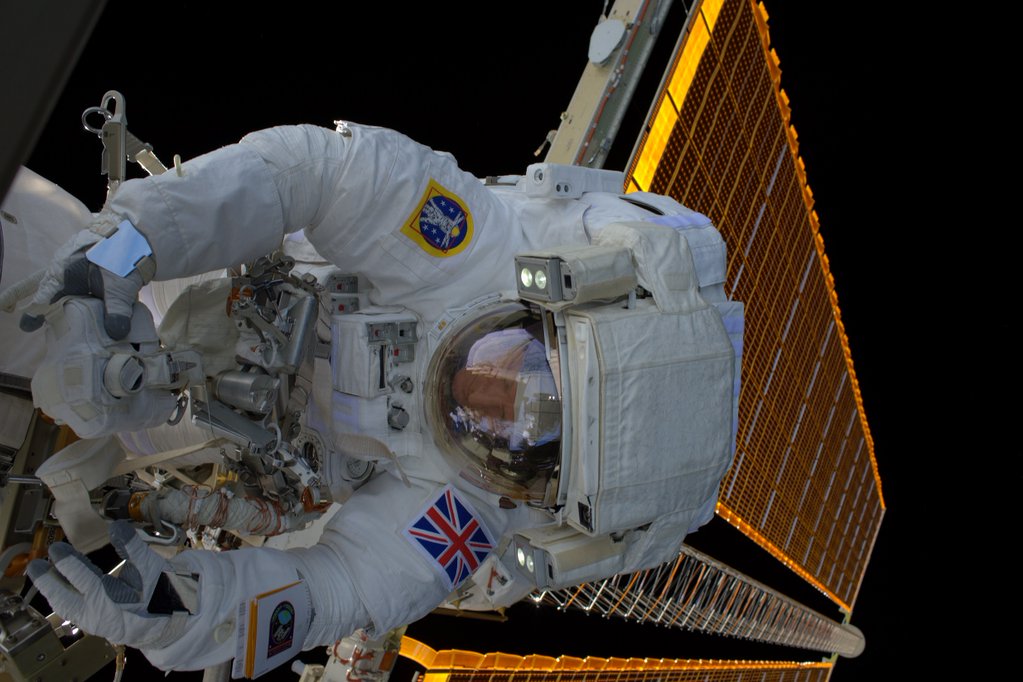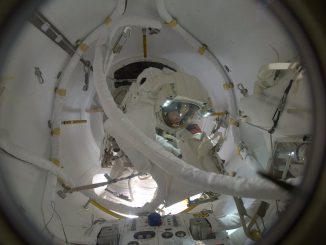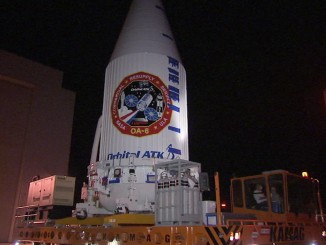STORY WRITTEN FOR CBS NEWS & USED WITH PERMISSION

Flight controllers ordered two astronauts to terminate a spacewalk outside the International Space Station Friday after one of them reported a small amount of water leaking into his space helmet. While not nearly as dangerous as a 2013 helmet leak that threatened to drown an Italian spacewalker, flight controllers took no chances, ordering both men back to the station’s airlock.
As it turns out, the spacesuit worn by Timothy Kopra Friday is the same suit — serial number 3011 — worn by European Space Agency astronaut Luca Parmitano during the frightening July 2013 EVA, NASA officials said
The suit was extensively modified in the wake of that incident and used successfully as recently as Dec. 21. It’s not yet known if the cause of the leak Kopra experienced Friday was related in any way to the much more serious problem faced by Parmitano, but extensive troubleshooting is expected to pin down what went wrong this time around.
Kopra and British astronaut Timothy Peake began the excursion at 7:48 a.m. EST (GMT-5) to kick off a planned six-and-a-half-hour spacewalk, the first so far this year and the 12th NASA EVA since the 2013 incident.
The primary goal of the outing was to replace a presumably shorted out sequential shunt unit, or SSU, at the far right end of the station’s solar power truss truss that failed last November and knocked one of the lab’s eight electrical channels out of action.
The SSU swap-out went smoothly and a few minutes later, flight controllers reported power channel 1B was back in normal operation. Kopra and Peake then hauled the failed unit back to the airlock, stowed it and went their separate ways to carry out several other lower-priority tasks.
Peake began laying out cables that will be needed by new docking mechanisms that will be installed later to support visits by Boeing and SpaceX crew ferry craft. Kopra focused on re-installing a non-propulsive vent on the hull of the Tranquility module that was removed last year.
It was at the end of that task, just a few minutes before noon, that Kopra reported a small bubble of water in his helmet.
“I’ll continue to monitor,” he called down to mission control in Houston.
“Why don’t you just hold right there,” replied astronaut Reid Wiseman in the control room. “Let us just talk this out for a second down here.”
“All right, sounds good.”
A few minutes later, Kopra managed to move he head enough to taste the water, saying it was “cold” and that the bubble was about a half-inch wide and two or three inches long. One other wild card on the table: a carbon dioxide sensor in Kopra’s suit failed earlier, although it’s not yet known whether that was related to the leak.
A moment after that, flight director Royce Renfrew, following guidelines established in the wake of Parmitano’s frightening EVA, ordered an early end to the spacewalk.
“We are in a terminate case,” Wiseman quickly called. “And we’re gathering words for Tim Peake and where we’ll leave you there.”
“So, terminate EVA, ingress crew lock, connect SCU (umbilicals),” Kopra confirmed, looking at a checklist attached to his suit. “So I’m going to bring up all my stuff here, Reid, and start heading back.”
A call to “terminate” an EVA means the crew should halt work, collect their tools and head back to the airlock. An “abort” call signifies an emergency, and that was not the case today, Renfrew said later.
In any case, within about a half hour both spacewalkers were back inside the Quest airlock. The hatch was then closed and the compartment was repressurized. The spacewalk officially ended at 12:31 p.m. after a duration of four hours and 43 minutes.
A few minutes later, station commander Scott Kelly and cosmonaut Sergey Volkov helped Kopra back into the roomier external airlock compartment, got his helmet off and collected water samples to help engineers pinpoint the source.
“When Tim reported the water bubble today, the size was a concern,” said chief astronaut Chris Cassidy, who was outside with Parmitano during the July 2013 incident. After reporting the bubble, Kopra told flight controllers that a water-absorbent pad at the back of his helmet was damp.
The HAP, or helmet absorption pad, was implemented in the wake of Parmitano’s close call to give spacewalkers early warning of a leak. A straw-like snorkel extending down into the body of the spacesuit is also available now to help a spacewalker breathe during a major water intrusion.
The water bubble in Kopra’s helmet, along with his report of a damp HAP, “said there was something going on,” Cassidy said. “But for me, the big hook is the temperature of the water. As soon as he could tell that it’s cold water, there’s something going on where that’s coming from, a source in the backpack, which is a significant concern to us.”
“So these procedures really did their job today, the team did their job and we flowed right into a nice, safe return back into the airlock for these guys.”
Kelly later reported that Peake’s suit was generally dry throughout, but Kopra’s was clearly damp.
“Tim Kopra was wet, not soaking wet, but just kind of moist up by his shoulders and by his wrists and his LCVG (liquid cooling and ventilation garment) had condensation around it,” Kelly said. “And in the ventilation line and water connector, there was moisture.”
During the spacewalk by Parmitano and Cassidy on July 16, 2013, water backed up into Parmitano’s helmet, quickly obscuring his vision and expanding around his head. He made it back to the station’s airlock, but it was a life-threatening malfunction.
In the wake of that incident, NASA carried out extensive troubleshooting and eventually blamed the water backup on a clogged filter in the suit’s water cooling system. Refurbished components were launched to the station, including a refurbished fan-separator module for the backpack of the suit worn by Parmitano and Kopra.
Along with new procedures to inspect and test spacesuits before an EVA, NASA also developed the HAP and the emergency snorkel to provide warning an an unobscured breathing line in case of a major leak. During spacewalks, flight controllers periodically ask the astronauts to report on the HAP, which can be felt by simply tilting the head back inside the helmet.
Those procedures paid off Friday, giving the crew plenty of time to get back to the Quest airlock before the leak in Kopra’s helmet could worsen.
Up until the leak was reported, the astronauts had been sailing through a virtually problem-free spacewalk. Peake is the second British citizen to fly in space, the first to visit the International Space Station and the first to carry out a spacewalk.
“Tim, it’s really cool seeing that Union Jack go outside since it’s explored all over the world,” Kelly radioed at the start of the spacewalk. “Now it’s explored space.”
“Thank you, Scott,” Peake replied. “It’s great to be wearing it. A privilege, a proud moment.”
Evan former Beatle Paul McCarney chimed in, tweeting: “Good luck @astro_timpeake we’re all watching, no pressure! Wishing you a happy stroll outdoors in the universe. All the best, PMc #spacewalk
The astronauts had no problems replacing the failed voltage regulator and flight controllers later reported the newly-installed unit was operating normally.
It’s not yet known what impact the leak in Kopra’s helmet might have on downstream plans. The next NASA spacewalk is tentatively planned for May, but that will depend on a variety of factors, including upcoming cargo launches and the spacesuit troubleshooting.



